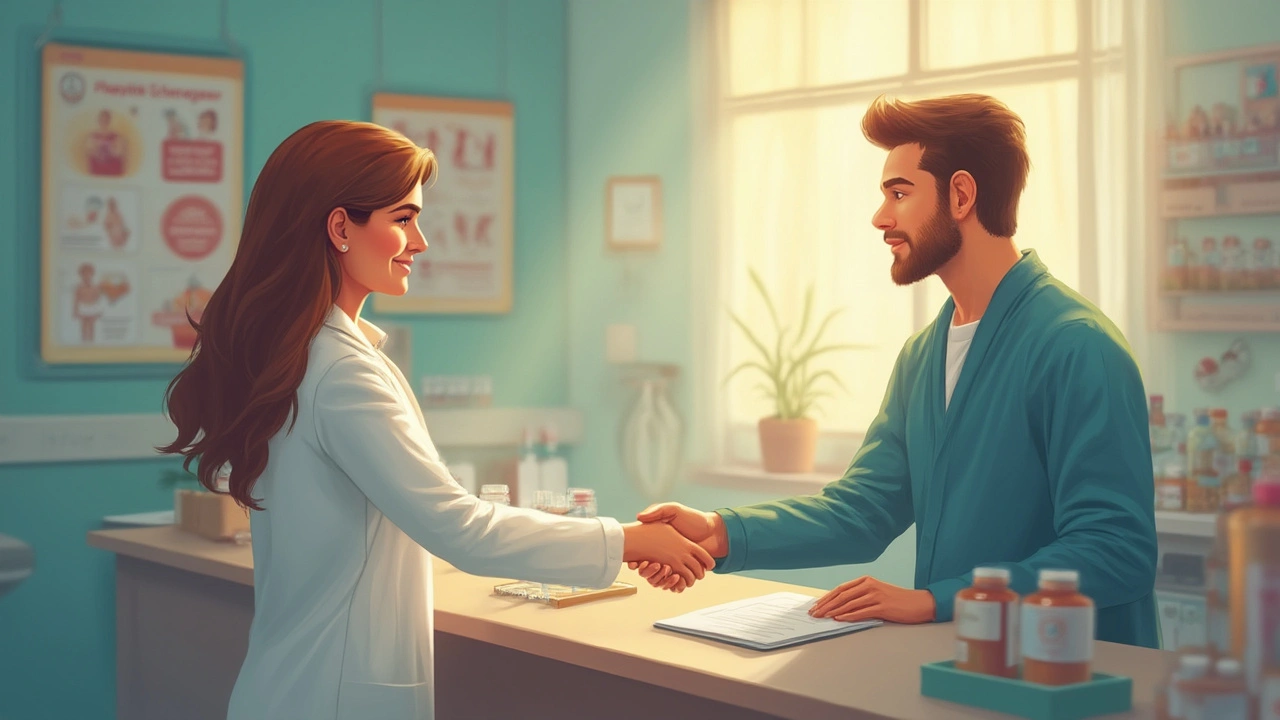
Ever wonder why your pharmacist asks so many questions, even about things you didn’t come in for? There’s a reason communication between pharmacists and patients has become one of the hottest topics in healthcare these days. With more people relying on pharmacies not just for medicines but also advice, vaccines, and even mental health support, the way these interactions play out can mean the difference between feeling heard and falling through the cracks. Lately, research out of major medical centers like the Mayo Clinic and Cleveland Clinic keeps showing that trust and strong communication with pharmacists actually make people healthier and, believe it or not, happier with their overall medical care. Yet building trust can get complicated—fears, misunderstandings, and frustration crop up everywhere from the prescription counter to late-night calls for emergency antibiotics. So, how can we make these vital conversations better?
Why Pharmacist-Patient Communication Matters
Pharmacy visits used to be a quick, transactional affair—a quick hello and a bottle in a paper bag. That’s changed. Now, you’ll catch pharmacists screening for drug interactions, giving flu shots, and even spotting early signs of diabetes or hypertension. That shift is partly because pharmacists are legally required in most states to provide counseling about every new medication you’re prescribed. But it’s also because studies—like a 2023 national survey published in the Journal of the American Pharmacists Association—show that patients who talk openly with pharmacists are more likely to stick with their medications and less likely to wind up in the hospital.
Let’s get real: nearly half of all Americans take at least one daily prescription drug, but more than one in four don’t take it as directed. Poor communication is often to blame. Ever been confused about whether to take a pill with or without food? Or maybe you’ve worried about weird side effects but didn’t want to ask. That’s when trust—that invisible safety net—matters. When people trust their pharmacist, they’re honest about missed doses, allergies, or even struggles with cost. In fact, pharmacists are now directly involved in teaming up with doctors, nurses, and insurance companies to prevent mix-ups. This works best when communication is clear, honest, and built on trust.
Pharmacists spend about 70% of their day talking with people—it might be explaining a tricky prescription, flagging possible drug allergies, or guiding someone through managing chronic conditions. Trust isn’t just a feel-good bonus. It translates to better health outcomes, fewer miscommunications, and a lot less stress for everyone involved.
The Building Blocks of Trust in the Pharmacy
So, what actually forges that all-important trust between pharmacists and patients? It boils down to a handful of habits and qualities, most of them simple but surprisingly rare.
- Listening, not just hearing—Patients notice right away when someone’s really paying attention. A landmark 2022 survey published in Pharmacy Times found that feeling listened to was the number-one factor in patient trust.
- Transparency—Pharmacists who explain things clearly, break down medical jargon, and admit when they don’t have an answer help melt away anxiety and fear. No one likes to be left in the dark about their own health.
- Empathy—Bad news, scary symptoms, or complex conditions? Empathy goes a long way. Patients trust pharmacists who react like fellow humans, not robots reciting protocols.
- Consistency—When the same pharmacist remembers your name or asks about your recovery, it creates comfort. It signals reliability and commitment.
- Privacy—Trust can quickly vanish without discretion. The best pharmacies design their spaces—like private booths or sound-absorbing panels—so you can talk openly without worrying about eavesdropping.
Small touches matter. Something as tiny as maintaining eye contact, writing down instructions, or checking in about side effects can make a world of difference. Studies show that even just offering a seat or leaning in to listen can lower anxiety and boost people’s confidence in their care team. The right questions also help. Instead of a dry “Any questions?” at checkout, pharmacists can ask, “What concerns do you have about starting this medicine?” This encourages real dialogue instead of awkward yes/no answers.

Real-Life Barriers: Why Trust Sometimes Falters
It sounds so easy in theory, but plenty can get in the way of strong pharmacist-patient relationships. One sneaky challenge? Time crunches. During cold and flu season, the pharmacy can feel like an airport at Christmas. Pharmacists are stretched thin, filling hundreds of prescriptions and juggling walk-in requests. Sometimes patients feel rushed—like they’re just another face in the drive-thru—while pharmacists feel overwhelmed by the pressure to move quickly and hit targets.
Another barrier is health literacy. Nearly nine out of ten adults in the United States have trouble understanding complex medical terms or instructions, according to the Centers for Disease Control and Prevention. That’s a huge gap that leads to confusion and mistakes. People also bring their own baggage—past bad experiences, distrust of healthcare, language gaps, or money stress can make open communication tough. Fear of being judged or embarrassed can stop someone from asking about sensitive issues or costs.
Technology is a mixed bag too. While electronic scripts and text reminders help catch problems, digital walls can keep conversations from feeling personal. As more telepharmacy platforms pop up, pharmacists and patients have to work extra hard to maintain that sense of trust without face-to-face moments. Yet creative solutions, like video consultations and secure messaging, are starting to fill some of these gaps.
And then there’s the issue of bias. Implicit bias—those sneaky judgments we don’t always realize we’re making—can affect how patients are treated or how much they trust a provider. Recognizing and addressing biases is crucial for building an open, respectful environment where everyone feels safe and heard.
Strategies to Strengthen Communication and Trust
When trust feels shaky, there’s no need to just hope things get better on their own. Both patients and pharmacists can do plenty to make their interactions friendlier and more helpful. Here are tried-and-tested strategies that actually work:
- Ask questions, even the "awkward" ones. Whether it’s about side effects, dosage, or costs, no question is too small. Pharmacists expect it.
- Bring a medication list, especially if you’re seeing multiple doctors. This helps your pharmacist catch possible interactions or duplications.
- Share worries about affordability. Many pharmacies now have discount programs or can recommend generics that work just as well for less.
- Pharmacists should personalize counseling. Address the patient by name, mention previous interactions, and reference unique patient needs (like gluten allergies or faith-based restrictions).
- Use the “teach-back” method. Pharmacists ask patients to repeat information in their own words—this confirms everything’s clear and prevents harm.
- Embrace plain language. Skip the Latin. The word "hypertension" means nothing if a patient doesn’t know it means "high blood pressure." Use clear, familiar terms.
- Address language barriers with written materials in multiple languages, translation services, or even visual aids for complicated instructions.
- Keep conversations private as much as possible. If the pharmacy is busy, step aside or schedule a private follow-up call.
- Pharmacists should keep learning—ongoing training in empathy, cultural competence, and communication pays off in quicker trust-building.
Tiny tweaks—like offering a cup of water for pill-taking, writing instructions in larger print, or checking in about mental health side effects—help turn sterile counters into caring spaces. Patients who get used to collaborating with their pharmacist are more likely to share updates about new symptoms, life changes, or mental health dips that could affect their medication. That means problems get caught early, before they become emergencies.
One cool development: many pharmacies now offer “medication therapy management” sessions. Patients can book one-on-one time with their pharmacist to review all their meds, map out a plan, and get every question answered—no rush, no crowd. These services are usually free or covered by insurance and can be a game-changer for people juggling lots of medications or chronic conditions.

The Future of Pharmacist-Patient Relationships
Pharmacies are not what they used to be, and neither are the conversations happening at the counter. As healthcare keeps shifting, pharmacists are becoming more like coaches—guiding patients through tough choices, advocating for mental health, and collaborating with whole teams of healthcare professionals. Trust will only get more important from here. With telehealth, smartphone apps, and artificial intelligence entering the mix, people need trusted human guides to sort through the noise and help make the best choices for their health.
But here’s the real kicker: when people trust their pharmacist, the data shows they stick to treatments, flag dangerous drug combos, and recover faster. A 2024 systematic review in the International Journal of Clinical Pharmacy found that strong pharmacist-patient bonds shaved days off hospital recovery times and cut ER visits by nearly 30%. For parents managing sick kids, caregivers supporting elderly relatives, or anyone feeling lost between doctors’ visits, pharmacists are a lifeline.
Patients aren’t just passive recipients anymore. More people are getting comfortable with tracking their own blood sugar, monitoring blood pressure at home, or even doing genetic testing with pharmacy consultations. Pharmacists help interpret results, ease worries, and filter internet myths from real advice. This “shared responsibility” model is becoming the new normal—and it depends on communication you can actually trust.
So next time you’re standing in line at the pharmacy, take a moment to look up from your phone. Behind that counter is someone who wants to help, listen, and keep you healthy—not just refill your prescription. And the conversations you have together? They’re more powerful than most people realize.

